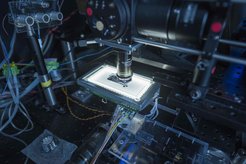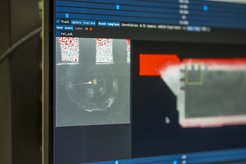
Systems Neuroscience & Neuroengineering
The RoLi lab is a joint lab between Drew Robson and Jennifer Li. Our lab has two primary areas of focus - Systems Neuroscience and Neuroengineering. We develop novel imaging systems to record and manipulate neural activity in freely swimming larval zebrafish. We use these tools to gain a deeper understanding of the neural mechanisms that control internal brain states, such as motivation and attention. Broadly speaking, we are interested in the interaction between neuromodulatory systems and global brain states, as well as state-dependent modulation of decision making during behaviors such as navigation, foraging, and operant learning.
Neuroengineering

Larval zebrafish has emerged as an ideal system for brain-wide cellular resolution calcium imaging due to itssmall nervous system and high optical transparency. However, existing imaging methods require this animal to be tethered under a microscope, which significantly restricts the range of behaviors the animal can perform. To overcome this limitation, our lab has developed a new generation of microscope systems that enable whole-brain imaging and manipulation in freely swimming larval zebrafish.
Using this system, our lab aims to expand the repertoire of natural behaviors that can be studied with cellular resolution calcium imaging, including spatial navigation, social behavior, feeding, and reward.
Systems Neuroscience

The internal state of an animal sets its behavioral priorities and modulates its motor performance. While some internal states such as sleep have predictable rhythms coupled to circadian cycles, others occur spontaneously during wakefulness. Humans show spontaneous attentional fluctuations in the ability to focus on cognitively demanding tasks. Awake rodents spontaneously alternate between active and inactive states in their home cage. C. elegans spontaneously alternates between roaming and dwelling states during feeding. However, our knowledge of the neural mechanisms that underlie these internal brain dynamics are still rudimentary.

Whole-brain calcium imaging in freely behaving larval zebrafish is ideally suited for uncovering the neuronal networks underlying internal brain states, by comprehensively sampling neuronal activity at cellular resolution throughout the brain under the conditions and timescales on which spontaneous behavioral state changes occur. Using the microscopy tools that we have developed in our lab, we are uncovering oscillatory networks in the zebrafish brain that shape the temporal structure of decision making. Our lab is interested in the role of neuromodulatory systems in coordinating internal brain states, and the interaction between internal brain states and decision making during navigation, foraging, and operant learning. We believe that understanding the neural underpinnings of internal state dynamics in healthy animals is a key step towards understanding their misregulation in pathological conditions such as ADHD or depression.


